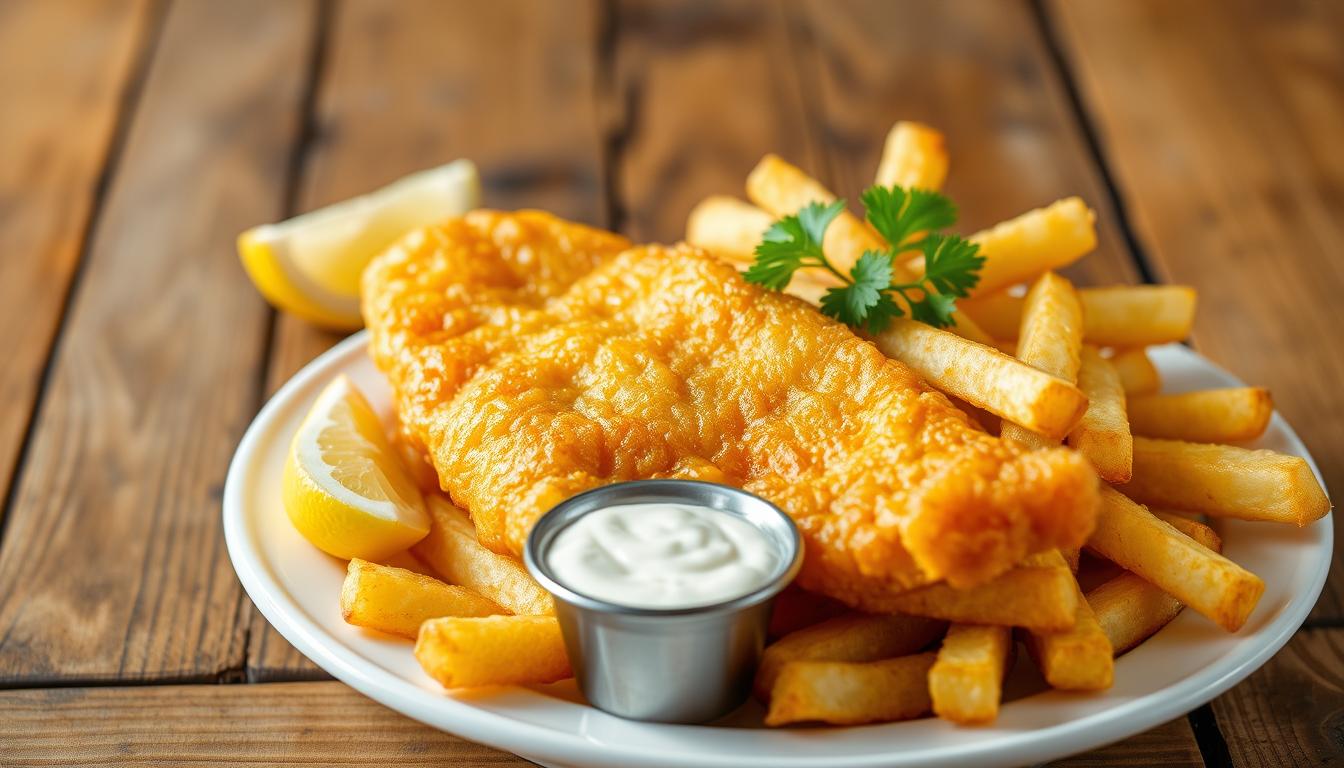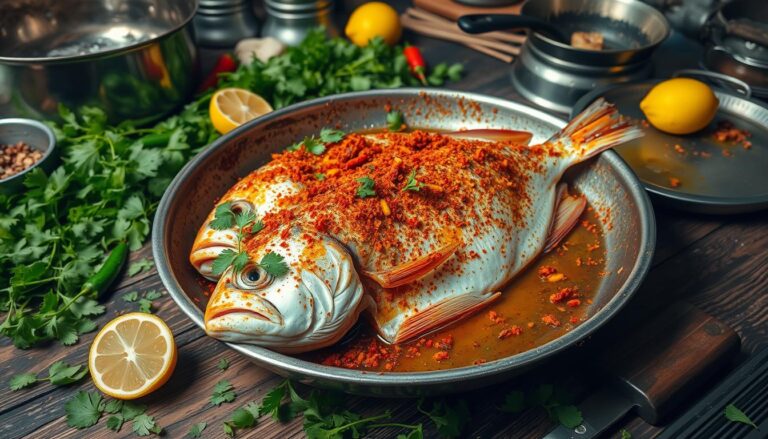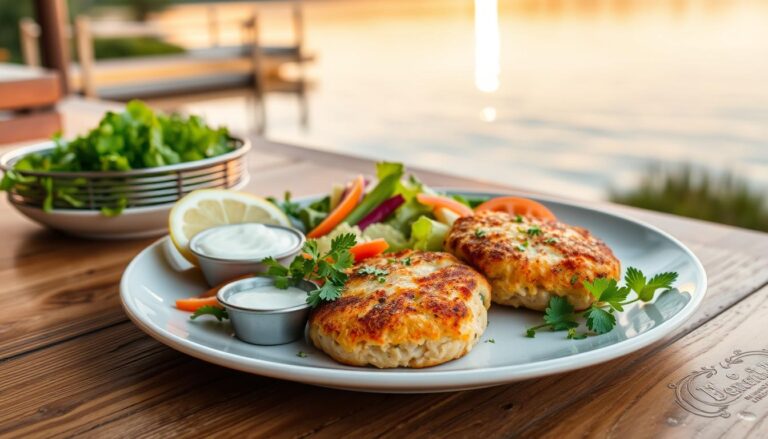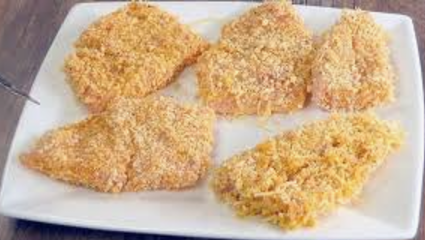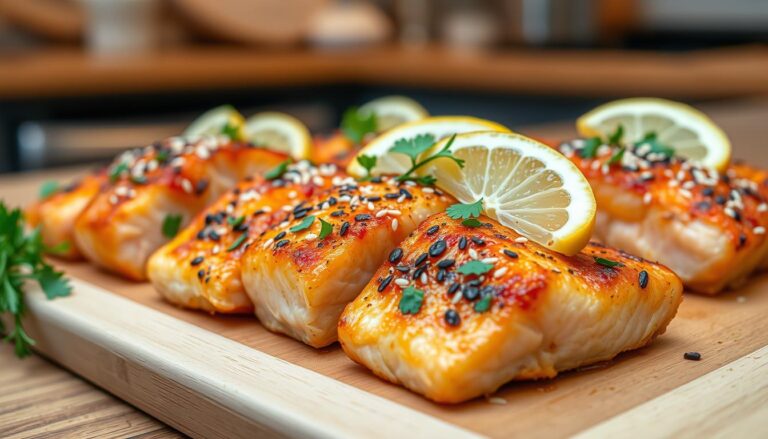Homemade Fish and Chips Recipe: Classic British Comfort

As autumn’s crisp air arrives, we all yearn for warm, familiar tastes. Homemade fish and chips are the perfect comfort food. This dish brings back memories of cozy pubs, seaside towns, and family gatherings. Let’s explore how to make this beloved dish at home, so you can enjoy British flavors from your kitchen.
Creating your own fish and chips is a rewarding journey. It doesn’t matter if you’re new to cooking or experienced. Each step, from choosing the right fish to mastering deep-frying, reveals the secrets of British flavor. With patience and the right techniques, you’ll make crispy, golden-brown fish and chips just like the classics.
Table of Contents
The Rich History Behind British Fish and Chips
The dish of British cuisine, fish and chips, has a rich history. It spans centuries and is a national treasure. It’s deeply woven into the UK’s culture.
The story of fish and chips starts in the 1860s. Jewish immigrants brought the tradition of frying fish to Britain. Around the same time, the potato-cutting machine was invented. This made it easier to make crispy, golden chips.
By the late 19th century, fish and chips became a classic dish. It merged the love for fried fish and crispy chips.
Over time, fish and chips have changed. They’ve adapted to British tastes. Now, you can find fish and chips shops everywhere. They offer a comforting meal to everyone.
“Fish and chips have become a symbol of British culture, representing the nation’s love for simple, high-quality ingredients and the traditions that have shaped its culinary heritage.”
Today, the fish and chips tradition is still strong. Restaurants and pubs across the country try to perfect the recipe. They also offer new twists on this beloved dish. Whether it’s a casual meal or a special treat, fish and chips is a cherished part of British cuisine.
Essential Ingredients for Authentic Fish and Chips Recipe
Making the perfect fish and chips starts with the right ingredients. You need flaky, moist battered cod and crispy, golden potato chips. Each part is key to a classic British taste. Let’s explore the must-haves for your homemade dish.
Selecting the Perfect Fish Varieties
The fish is the main star. Choose varieties that are firm, flaky, and mild. Here are some top picks:
- Cod: A favorite for its delicate texture and sweet taste.
- Haddock: Offers a firmer bite and sweeter flavor.
- Halibut: Versatile and tender, even after frying.
Must-Have Batter Components
The batter makes your battered cod golden and crispy. You’ll need:
- All-purpose flour: Essential for a crispy batter.
- Carbonated water: Adds air for a light texture.
- Seasonings: Salt, pepper, and spices for flavor.
Potato Selection Guide
For potato chips, choose starchy potatoes for crispiness. Good options are:
| Potato Variety | Characteristics |
|---|---|
| Russet Potatoes | High in starch, for a light chip. |
| Yukon Gold Potatoes | Good balance of starch and creaminess. |
| Red Potatoes | Waxy texture for a heartier chip. |
With these ingredients, you’re ready to make delicious fish and chips. Quality ingredients are crucial for a great dish.
Kitchen Tools and Equipment You’ll Need
To make perfect fish and chips at home, you need the right kitchen tools. A deep fryer, thermometer, and more are key. They help you get that crispy, golden-brown finish. Let’s explore the essential items for a great deep frying and fish and chips recipe experience.
The Deep Fryer
A good deep fryer is crucial for making fish and chips like a pro. Choose one with a big capacity, adjustable temperature, and strong build. This ensures even frying. Some deep fryers even have oil filters for easy cleaning.
Cooking Thermometer
Keeping the oil at the right temperature is key for perfect deep frying. A reliable thermometer, especially one with a long probe, helps you keep an eye on the temperature. This way, you can adjust it as needed.
- Choose a thermometer that can handle high heat and gives accurate readings.
- Digital thermometers are great for easy, precise temperature checks.
Slotted Spoon and Tongs
A slotted spoon and sturdy tongs are vital for handling the battered fish and chips. The slotted spoon drains excess oil, while the tongs help you move things around carefully.
| Tool | Purpose |
|---|---|
| Deep Fryer | Provides consistent, even heating for deep frying the fish and chips |
| Cooking Thermometer | Ensures the oil temperature is maintained at the optimal level for fish and chips recipe |
| Slotted Spoon and Tongs | Facilitates the transfer of battered fish and hand-cut chips in and out of the hot oil |
With these tools, you’re ready to make delicious homemade fish and chips. The right equipment is crucial for that perfect, crispy, golden-brown finish.
Perfect Batter Mixing Techniques
Making the perfect batter for your fried fish and battered cod is key to a great British fish and chips dish. We’ll cover temperature control and consistency secrets to improve your batter.
Temperature Control Tips
Keeping your batter cold is crucial for a crispy exterior. Chill your ingredients to 40-50°F (4-10°C) before mixing. This keeps the batter’s structure and prevents it from getting too thin or runny when frying.
Consistency Secrets
- Get the right consistency by slowly adding liquids to dry mix, whisking to avoid lumps.
- The batter should be like heavy cream, coating a spoon without dripping.
- If it’s too thick, add a bit more liquid until it’s just right.
Seasoning Balance
Seasoning is vital for flavor in your fried fish batter. Use salt, pepper, and herbs or spices. Taste and adjust the seasoning to balance the flavor with the fish.
| Ingredient | Quantity |
|---|---|
| All-purpose flour | 1 cup |
| Cornstarch | 2 tablespoons |
| Baking powder | 1 teaspoon |
| Salt | 1 teaspoon |
| Black pepper | 1/2 teaspoon |
| Chilled soda water | 1 cup |
Mastering these techniques will help you make a crispy, golden-brown coating for your fried fish and battered cod. Enjoy your delicious results!
How to Cut and Prepare Your Potatoes
Making the perfect fish and chips recipe begins with potato prep. You can go for thick-cut chips or thin potato chips. The cut and prep method is key.
First, pick the right potato. Russet or Yukon Gold are best for crispiness. Stay away from watery or starchy potatoes, as they don’t fry well.
- Thoroughly wash the potatoes and pat them dry with a clean kitchen towel.
- Slice the potatoes lengthwise into even, uniform strips, ensuring they are the desired thickness – typically around 1/4 to 1/2 inch thick for traditional chips.
- If making potato chips, use a mandoline slicer or sharp knife to cut the potatoes into paper-thin slices.
- Soak the potato slices or strips in ice water for at least 30 minutes to remove excess starch, then pat them dry completely with paper towels.
Getting the potatoes dry is essential for crispiness. Once prepped, you’re set to fry them to golden perfection.
“The secret to great homemade potato chips lies in the careful preparation of the potatoes.”
The Art of Deep Frying Fish
Learning to deep fry fish is key to getting that perfect crispy outside and juicy inside. Whether it’s deep fried fish or fish and chips, knowing about oil temperature, coating, and frying is important. It helps you get consistent, delicious results every time.
Oil Temperature Management
Keeping the oil at the right temperature is crucial. For deep frying fish, aim for 350°F to 375°F. Use a kitchen thermometer to check the oil’s temperature. Adjust the heat to stay in this range.
Coating and Frying Methods
To get the best batter, start with a light flour or cornmeal coating on your fish. Then, dip it in a seasoned batter. Make sure to remove any extra batter before frying.
Fry the fish in batches to avoid lowering the oil temperature. Flip the fillets often to cook evenly and get that golden color.
Golden-Brown Perfection Tips
- Use a deep, heavy-bottomed pan or Dutch oven for better oil depth and temperature control.
- Pat the fish dry with paper towels before coating to prevent splatters.
- Fry until the fish is golden brown and flakes easily with a fork.
With practice and attention to detail, you’ll make fried fish that’s as good as in a restaurant. Serve it with crispy chips and your favorite sauces for a classic British dish.
Crafting Crispy Hand-Cut Chips
Making perfect homemade potato chips is an art. The secret to potato chips that are golden and crunchy is in the frying. Follow these tips to make delicious potato chips at home.
Double-Fry for Maximum Crispness
The double-fry method is the secret to super crispy chips. First, fry the slices at a lower temperature to cook them. Then, fry them again at a higher temperature for that perfect crunch.
- Fry the potato slices at 325°F (165°C) for 5-7 minutes, until just tender but not browned.
- Carefully remove the par-cooked chips and let them cool for a few minutes.
- Increase the oil temperature to 375°F (190°C) and fry the chips a second time for 2-3 minutes, until golden-brown and crispy.
Achieve the Ideal Texture
Getting the right texture is key for potato chips. Here’s how to get it right:
- Slice the potatoes evenly: Uniform thickness ensures even cooking and prevents some chips from burning while others are undercooked.
- Soak the potato slices: Soaking the cut potatoes in cold water for 30 minutes helps remove excess starch, resulting in crispier chips.
- Dry the potatoes thoroughly: Patting the potato slices dry with paper towels before frying prevents splattering and ensures maximum crispness.
With these techniques, you’ll make the most delicious homemade potato chips. Your friends and family will love them.
“The key to perfect potato chips is in the frying technique. Follow these steps, and you’ll be rewarded with an irresistible crunch in every bite.”
Traditional Accompaniments and Sauces
No fish and chips experience is complete without classic accompaniments and sauces. Homemade tartar sauce and mushy peas are key to this beloved British dish. Let’s dive into how to make these condiments and how they enhance your dish.
Homemade Tartar Sauce Recipe
Tartar sauce is perfect with crispy fish. You’ll need mayonnaise, chopped dill pickles, lemon juice, salt, and Dijon mustard. Mix all in a bowl until smooth. This sauce adds a creamy, tangy flavor to your fish and chips.
Mushy Peas Preparation
Mushy peas are a must with fish and chips. Start by boiling fresh or frozen peas until they’re tender. Then, mash them until soft. Add salt and butter or cream for extra richness.
Malt Vinegar Usage
A drizzle of malt vinegar completes the dish. It adds a tangy, sweet contrast to the crispy batter and fish. Keep malt vinegar on hand for guests to add their own flavor.
| Accompaniment | Preparation | Flavor Profile |
|---|---|---|
| Tartar Sauce | Combine mayonnaise, pickles, lemon juice, salt, and Dijon mustard | Creamy, tangy, and slightly sweet |
| Mushy Peas | Simmer peas, then mash with butter or cream | Soft, comforting, and subtly sweet |
| Malt Vinegar | Drizzle over the fish and chips | Tangy, slightly sweet, and complementary |
Try these traditional accompaniments and sauces for a true British fish and chips experience. Whether you love tartar sauce, mushy peas, or malt vinegar, these pairings will make your homemade dish even better.
Troubleshooting Common Fish and Chips Problems
Making the perfect fish and chips recipe at home is a fun journey. But, it comes with its own set of challenges. Whether you face soggy batter, undercooked fish, or greasy fried fish, don’t worry. We’ve got expert tips to help you get it just right.
Preventing Soggy Batter
A soggy batter is a common issue. To avoid it, keep your oil between 350°F and 375°F. Also, try these tips:
- Pat the fish fillets dry with paper towels before dredging in the batter.
- Use a light, tempura-style batter that’s well-chilled before frying.
- Fry the fish in small batches to maintain the oil temperature.
Ensuring Perfectly Cooked Fish
Undercooked fish can be a letdown. To fix this, use a digital thermometer to check the fish’s internal temperature. It should be 145°F. Also:
- Choose thick, meaty fish fillets for even cooking.
- Adjust the frying time based on the fish’s thickness.
- Avoid overcrowding the oil to prevent uneven cooking.
Achieving Crispy, Non-Greasy Chips
Greasy, soggy chips can spoil a great fish and chips meal. To get crispy, non-greasy chips, follow these tips:
| Tip | Explanation |
|---|---|
| Double Fry the Chips | Fry the potatoes twice – first at a lower temperature to cook them through, then at a higher temperature to crisp them up. |
| Use the Right Potato Variety | Choose starchy potatoes, like Russets or Yukon Golds, for a crisper texture. |
| Dry the Potatoes Thoroughly | Pat the potato slices dry before frying to prevent excess moisture. |
By tackling these common problems, you’ll be on your way to making perfect fish and chips at home. Enjoy the journey and relish the delicious outcome!
“The secret to the best fish and chips is in the details. With a little troubleshooting and attention to technique, you can master this classic British dish at home.”
Serving and Presentation Tips
Make your homemade fish and chips stand out with great serving and presentation. Use a traditional platter or basket to show off your crispy fish and chips. Make sure the fish is the main attraction and the chips are neatly stacked.
Traditional Plating Methods
Serve your fish and chips like the British do. Use a sheet of newspaper or parchment paper to add to the charm. It keeps the dish warm and crispy. Don’t forget to add a lemon wedge for a burst of citrus flavor.
Garnishing Ideas
Add some flair to your fish and chips with garnishes. A sprig of parsley or chives brings freshness. Thin lemon wedges around the plate let guests add a tangy touch.
